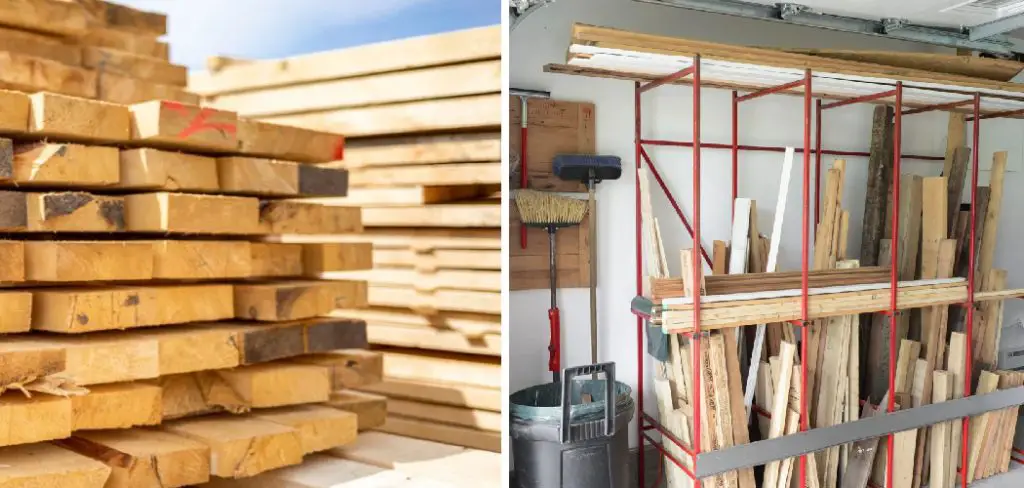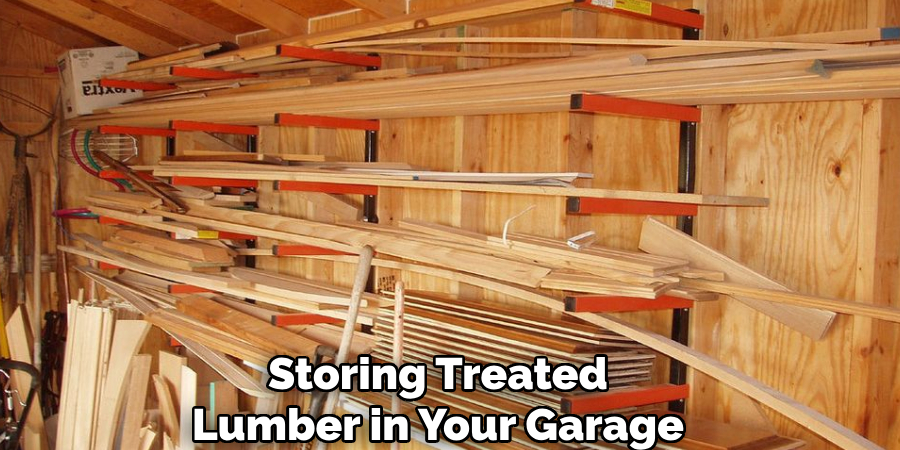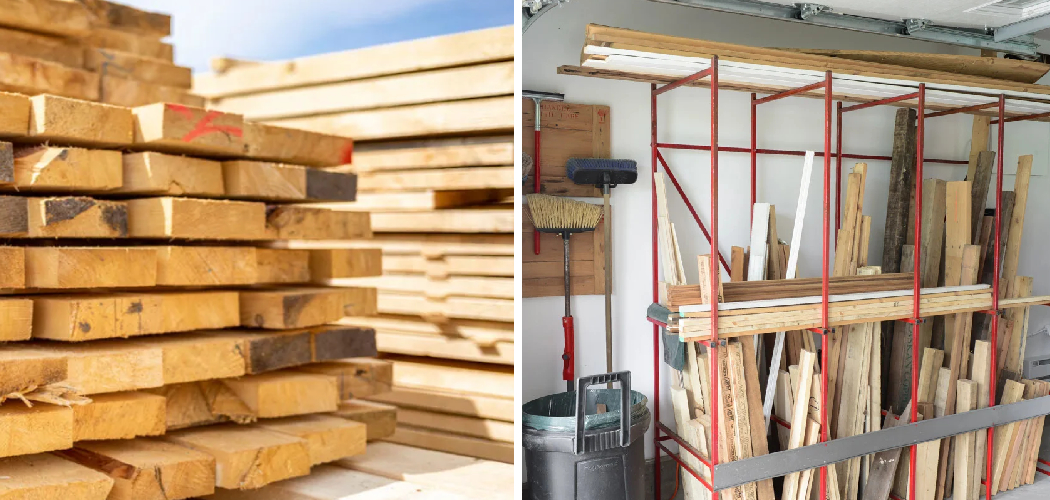Storing lumber in a garage is a common practice for many homeowners, especially those who have limited storage space. Lumber can be used for various purposes such as building furniture, constructing decks and patios, or even for home renovation projects.

However, storing lumber in the garage requires specific knowledge and techniques to ensure that it stays in good condition and does not pose any safety hazards.
The main advantage of storing lumber in your garage is that it provides a convenient and easily accessible storage space for your materials. This can help keep your woodworking projects organized and efficient, as well as protect your lumber from damage caused by weather or pests. In this blog post, You will learn in detail how to store lumber in garage.
Step by Step Processes for How to Store Lumber in Garage
Step 1: Inspect the Lumber
Check for any signs of rot, mold or insect infestation. If the lumber is damaged, it’s best to dispose of it as storing damaged lumber can lead to further damage and potential safety hazards.
Step 2: Sort by Type and Size
Sort the lumber into different piles based on its type (e.g. dimensional, plywood, studs) and size (e.g. 2x4s, 4x4s). This will make it easier to find the specific lumber you need for a project.
Before storing the lumber, make sure the garage space is clear of any debris or clutter. Sweep or vacuum the area to remove any dust that could potentially damage the lumber.
Step 3: Choose a Storage Method
There are various storage methods that can be used to store lumber in the garage, such as vertical racks, horizontal shelves, or wall-mounted brackets. Choose the best method based on the amount of space you have and the type of lumber you need to store.

When storing lumber vertically, make sure to stack it neatly and evenly so that it doesn’t tip over. For horizontal storage, place the lumber flat on shelves or racks, making sure they are level to prevent warping.
Step 4: Label Lumber
To make it easier to find specific pieces of lumber, use labels or markers to identify each pile. This will save time and effort when looking for a particular type or size of lumber. To prevent moisture damage to the lumber, make sure the storage area is dry and well-ventilated. If necessary, use dehumidifiers or moisture-absorbing materials such as silica gel packs.
Step 5: Consider Temperature Control
Extreme temperature changes can affect the quality of the lumber. If possible, try to maintain a consistent temperature in the storage area to minimize any potential damage. Storing lumber directly on the ground can lead to moisture absorption and potential rotting. Use pallets or blocks to elevate the lumber and keep it from touching the ground.
Step 6: Regularly Inspect and Rotate
It’s important to regularly inspect the lumber for any signs of damage or deterioration. Consider rotating the lumber piles periodically to avoid leaving them in one spot for too long.
By following these steps, you can effectively store lumber in your garage and ensure it stays in good condition until you need it for your next project. Remember to always prioritize safety when handling and storing lumber, and make sure to dispose of any damaged pieces properly.
Tips for How to Store Lumber in Garage
- Lumber is highly flammable. Therefore, it should be stored at least 3 feet away from any potential fire hazards such as heaters or electrical outlets.
- Adequate air circulation is crucial when storing lumber in a garage. This will help prevent moisture buildup which can lead to mold and rot.
- To prevent accidents, it is important to stack lumber in a way that heavier and longer pieces are at the bottom. This will prevent them from falling and causing injuries.
- Storing lumber on the ground can pose a tripping hazard and make it difficult to access. Utilizing shelves or racks will not only keep your garage neater but also make it easier to reach for the desired piece.
- Make sure to label your lumber. This will save you time and effort when searching for a specific piece. It will also help prevent confusion and potential mistakes.
- Use protective gear such as gloves and eye protection when handling lumber. Splinters and dust can cause irritation or injury if proper precautions are not taken.
- Regularly inspect and maintain your lumber storage area. Check for any signs of damage or deterioration, and make necessary repairs to ensure the safety and longevity of your lumber.
- Lastly, always keep a fire extinguisher in your garage in case of emergencies.

Can You Store Treated Lumber in a Garage?
If you have a garage or storage shed, it may be tempting to store your leftover lumber there. However, if the lumber has been treated with chemicals, such as pressure-treated wood, it is important to consider whether storing it in your garage is safe.
1. Types of Treated Lumber
There are various types of treated lumber on the market, but the most common is pressure-treated wood. This type of wood has been infused with chemicals to make it more resistant to decay and insect damage. Other types of treated lumber may include fire retardants or water repellents.
2. Potential Risks
While treated lumber may be safe for use in outdoor projects, there are potential risks associated with storing it in an enclosed space like a garage. The chemicals used to treat the wood can emit fumes that may be harmful if inhaled, especially in confined spaces.
3. Proper Storage
If you do choose to store treated lumber in your garage, it is important to take proper precautions. Make sure the garage is well-ventilated by opening windows and doors. You may also want to consider wearing a mask while handling the wood to protect yourself from any fumes. Additionally, it is important to keep treated lumber away from any sources of heat or flames.
4. Alternatives
If you are concerned about storing treated lumber in your garage, there are alternatives available. Some home improvement stores offer storage solutions specifically for lumber that can be kept outside and protected from the elements. You could also consider building a storage rack in your yard to keep the lumber off the ground and protected.

How Can You Protect Your Lumber From Moisture and Pests While Storing It in a Garage?
One of the most convenient places to store lumber is in a garage. It provides shelter from the elements and keeps your materials organized and easily accessible for projects. However, garages are not always the ideal storage environment for lumber.
Without proper precautions, your wood can be vulnerable to moisture and pests, which can significantly damage its quality and render it unusable. Here are some tips to help you keep your wood materials in good condition and ready for your next project.
1. Choosing the Right Storage Space
The first step to storing lumber in a garage is selecting the right storage space. The ideal location should have proper ventilation, minimal temperature fluctuations, and protection from moisture and pests. If possible, choose a space that is away from any windows or doors to avoid exposure to rain and high humidity levels.
2. Preparing the Space
Before storing your lumber, make sure to clean the designated area thoroughly. Sweep or vacuum the floor to remove any debris or sawdust that can attract insects. You may also consider installing shelves or bins to keep your wood off the ground and away from any potential moisture sources.
3. Protecting from Moisture
Moisture is one of the biggest threats to lumber stored in a garage. High humidity levels can cause wood to warp, crack, and even grow mold or mildew. To protect your lumber, invest in a dehumidifier for your garage or consider using moisture-absorbing materials such as silica gel packets or chalk.
You can also use a moisture meter to regularly check the humidity levels in your storage space. If the levels are too high, consider adding more moisture-absorbing materials or investing in a better dehumidifier.
4. Keeping Pests Away
Another concern when storing lumber in a garage is pests. Insects and rodents are attracted to wood, and they can quickly infest your materials if not properly protected. To keep pests at bay, make sure to seal any cracks or openings in your garage that could serve as entry points for insects or rodents.

Conclusion
The main disadvantage of storing lumber in a garage is that it takes up valuable space that could be used for other purposes. This can be especially problematic if the garage is small or already filled with other items. Additionally, if the lumber is not properly stored, it can pose a safety hazard as it may fall over or become damaged.
In conclusion, if you want to keep your garage organized and maximize the space available, it’s crucial to know how to store lumber properly. The first step is to assess your needs and determine the types of lumber you’ll be storing. From there, you can decide on the best storage solution for your specific situation.
I hope this article has been beneficial for learning how to store lumber in garage. Make Sure the precautionary measures are followed chronologically.
I am Rick. I grew up helping my dad with his handyman service. I learned a lot from him about how to fix things, and also about how to work hard and take care of business. These days, I’m still into fixing things- only now, I’m doing it for a living.
I’m always looking for new ways to help people grow and develop. That’s why I have created this blog to share all my experience and knowledge so
that I can help people who are interested in DIY repair.

